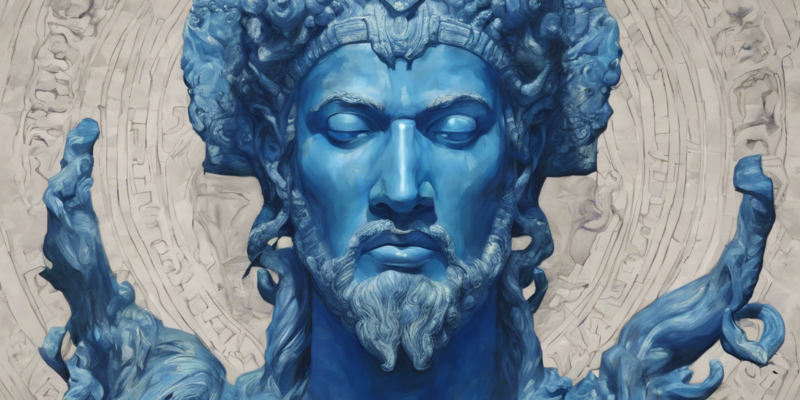Introduction
In the vast tapestry of mythology and folklore from around the world, there are numerous narratives that captivate our imagination and spark our curiosity. One intriguing figure that appears in various mythologies is the Blue God. This enigmatic and often misunderstood deity has been a significant presence in the religious and cultural beliefs of many civilizations throughout history. Let us delve into the myth of the Blue God, exploring its origins, symbolism, and significance across different cultures.
Origins of the Blue God
The concept of a deity with blue skin has its origins in ancient Indian mythology. In Hinduism, one of the world’s oldest religions, Lord Krishna is depicted with blue skin. Krishna, a major deity in Hinduism, is known for his playful and mischievous nature, as well as his profound wisdom and teachings. His blue complexion is said to symbolize his divine nature and transcendental qualities. According to Hindu scriptures, Krishna’s skin color represents the vastness and depth of the sky and the infinite nature of the universe.
Symbolism of Blue in Mythology
Blue is a color associated with various symbolic meanings in different cultures. In many mythological traditions, blue is linked to themes of divinity, spirituality, and transcendence. It is often seen as a color of protection, healing, and purity. The sky, with its infinite expanse and boundless possibilities, is often portrayed as a symbol of the divine in many cultures. In this context, the Blue God is seen as a representation of the higher self, the divine spark within each individual.
The Blue God in Different Cultures
Apart from Hinduism, the motif of the Blue God can be found in other mythological traditions as well. In ancient Egyptian mythology, the god Amun was sometimes depicted with blue skin. Amun was a powerful deity associated with creation and fertility, and his blue color symbolized his role as a bringer of life. In Chinese mythology, the god Ao Guang, the Dragon King of the Eastern Sea, was often portrayed with blue scales, representing his connection to the water element and his control over the seas.
The Blue God in Art and Literature
Throughout history, artists and writers have been inspired by the enigmatic figure of the Blue God. Paintings, sculptures, and poems depicting Krishna or other blue-skinned deities have captured the imagination of audiences around the world. From classical Indian art to contemporary interpretations in popular culture, the Blue God continues to be a source of inspiration and creativity for many artists and creators.
The Blue God in Popular Culture
In modern times, the concept of the Blue God has found its way into popular culture in various forms. From comic books and graphic novels to movies and video games, the image of the Blue God has been reimagined and reinvented for a new generation of audiences. Characters like Dr. Manhattan from the graphic novel “Watchmen” and the Na’vi people from the movie “Avatar” are examples of how the idea of a blue-skinned deity continues to resonate with contemporary audiences.
The Blue God and Spirituality
The symbolism of the Blue God extends beyond its mythological and cultural origins. Many people find inspiration and solace in the archetype of the Blue God as a symbol of spiritual awakening and transformation. The idea of connecting with the divine within oneself, represented by the Blue God, can serve as a powerful tool for personal growth and self-discovery. By embracing the qualities associated with the Blue God – wisdom, compassion, and transcendence – individuals can embark on a journey of inner exploration and enlightenment.
Conclusion
The myth of the Blue God is a fascinating and multifaceted aspect of world mythology that continues to intrigue and inspire people across cultures and generations. Whether seen as a symbol of divinity, a representation of the infinite cosmos, or a metaphor for spiritual awakening, the Blue God remains a potent archetype that speaks to the depths of the human soul. By exploring the origins, symbolism, and cultural significance of the Blue God, we gain a deeper understanding of the rich tapestry of myth and symbolism that has shaped human consciousness throughout history.
FAQs
- Is the Blue God a specific deity in any particular religion?
-
The Blue God is a symbolic figure found in various mythological traditions, with Lord Krishna in Hinduism being one of the most well-known examples.
-
What does the color blue symbolize in mythology?
-
Blue is often associated with divinity, spirituality, and transcendence in mythology, representing qualities such as protection, healing, and purity.
-
Are there other blue-skinned deities besides Lord Krishna?
-
Yes, figures like Amun in Egyptian mythology and Ao Guang in Chinese mythology are also depicted with blue skin.
-
How has the concept of the Blue God influenced art and literature?
-
Artists and writers have drawn inspiration from the Blue God, creating various works that explore themes of divinity, wisdom, and transformation.
-
In what ways can the symbolism of the Blue God be applied to spirituality and personal growth?
- The qualities associated with the Blue God, such as wisdom and transcendence, can serve as guiding principles for individuals seeking spiritual awakening and inner transformation.

